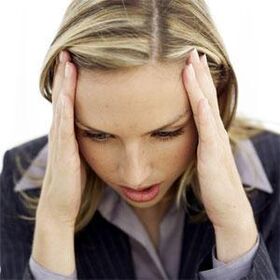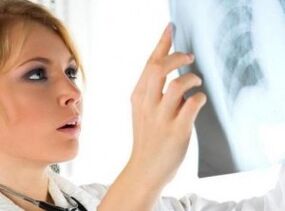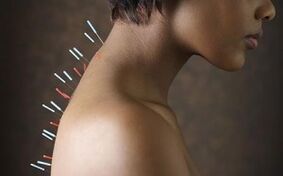Osteochondrosis today is correctly regarded as a “disease of the century” because most people are often suffering from the suffering of those who work without increasing their exercise.
In most cases, changes in cartilage and bone tissue were observed in working-age populations - up to 40 years.
The disease affects different parts of the spine, and the second most prevalent is the osteocartilage of the cervical spine.
What's this?
Osteocartilage is a malnutritional disease of articular cartilage and adjacent bone tissue.
Previously, the term extended to a large number of bone tool diseases, but is now used only with degenerative spinal diseases.

Compared to other spinal departments, the cervical region is the most fluid and has many nerve and blood vessel formation.The structural size of the vertebrae is small, and they are surrounded by a rather weak muscle corset.
This anatomy is prone to the development of osteochondrosis, and the severity of clinical manifestations depends on the nature and degree of damage of the disc changes.
Causes of disease development
The main and most common cause of cervical osteocartilage degeneration is a sedentary lifestyle.
Physical fatigue due to lack of a sedentary lifestyle:
- Invasion of metabolic processes;
- Increased levels of salt in the blood and lymph;
- In the cervical area, in the kidneys and liver of the spine, salt is laid.
Cervical spine injury mainly depends on the lack of nutrition in the intervertebral disc.Therefore, the main causes of cervical osteochondrosis also include improper nutrition and imbalanced nutrition.
Risk factors
There are many risk factors for cervical osteochondrosis.

The most common factors are:
- Genetics
- age-related changes;
- Cervical spine injury;
- Low temperature;
- Hormonal diseases that cause metabolic diseases;
- Some autoimmune diseases can cause damage to the cartilage tissue (systemic lupus erythematosus, rheumatism).
What is dangerous
Not only does the spinal cord and nerve root pass through the cervical vertebrae, but also through the vertebral artery, which is responsible for supplying blood from the back of the brain, the rectangular brain and the cerebellum.
Therefore, in the cervical bone cartilage, the artery is squeezed, resulting in violation of the cerebral circulation.
In particularly advanced cases, squeezing the arteries and adjacent vessels and nerve plexus may result in such consequences:
- Violation of coordination;
- Hearing and vision loss;
- Stroke.
If you do not cure the disease in the initial stage, it may lead to complications: a herniation of the disc or a herniation of the disc.
The degree of disease development
Cervical osteochondrosis, such as osteochondrosis in other spinal columns, develops at various stages.The disease has three stages of development.
1 degree
It is characterized by the beginning of destruction of the intervertebral disc.
The fibrils form in the annulus, forming the strength and elasticity of the intervertebral disc, which is reduced in height, so the nerve roots are squeezed.
A characteristic pain appeared.Sometimes, this pain may be missing in stage 1 (preclinical) and osteochondrosis can be moderately uncomfortable in the neck.
2 degrees
If the first degree of osteocartilage degeneration is not treated or the treatment is ineffective, a chronic disease occurs, which is the second degree of osteocartilage.
The pain becomes constant, the damage and seal of the intervertebral disc continues, and leads to a tiny volume of the cervical vertebrae.
With cervical bone cartilage degeneration, a reduction in head syndrome may occur at this stage.The syndrome is characterized by severe pain, and a person is forced to support his head in a fixed state to relieve pain.
3 degrees
Grade 3 cervical osteochondrosis is accompanied by the following signs:
- Headache;
- nausea;
- Dizziness;
- Cervical "bastard";
- Violating the sensitivity of the upper limbs.
The annulus of fibrous fibrous have been nearly destroyed, which can lead to complications of osteochondrosis - the herniation of the disc or disc hernia.
During the 3 stages of osteochondrosis, the intensity of the pain can be reduced because the affected cartilage tissue in the intervertebral disc does not exist at all, which means there is no source of pain, but the clamping of the nerve roots still exists, so the pain does not completely leave.
Characteristics and Symptoms
There are many signs of this disease.They depend on which vertebrae the disease has damaged.

The characteristic syndromes of cervical osteochondrosis are:
- Spine syndrome;
- vertebral artery syndrome;
- Cervical migraine syndrome;
- Hypertension syndrome.
First, all of these syndromes are accompanied by different types of pain.
If we consider the syndrome of the vertebral artery, the headache here will manifest in the early stages of the disease development.
Meanwhile, pain attacks may be accompanied by:
- Dizziness;
- Gait shake
- Visual symptoms (fog in front of the eyes, reduced vision, etc.).Faint (sharp head movement).
Use hypertension syndrome to determine increased intracranial pressure.
The headache is even more explosive, which may be accompanied by nausea and vomiting.As the cervical osteocartilage changes in intensify, temperature increases and ESR can be observed.
When compressing the spinal cord root (“Roying syndrome”), the following neurological symptoms may occur:
- Significant pain in the neck (cervical pain);
- Neck pain, spreading in the forearm and shoulder bones (cervical nucleic acid);
- Pain in the hands;
- The feeling of neck tightening or cod when turning the head;
- Pain "gives" the ears and only occurs after prolonged staying in uncomfortable positions or after a sharp exercise.
- Pain or sensation of the throat coma, respiratory disease;
- Numbness of hands and tongue;
- The feeling of swelling on the tongue;
- obvious weakness;
- Violation of hearing and vision;
- Noise in the ears;
- The general deterioration of the well.
It is accompanied by "cervical migraine" syndrome, which angers sympathetic lymph nodes, resulting in impaired responsiveness in cerebrovascular and circulatory diseases.

As a result, hypertension may be accompanied by:
- Ear congestion;
- tachycardia;
- Head noise;
- Calling the ears.
A spinal stroke may occur when blood supply is compressed to the spinal cord of the artery.
Destruction of blood circulation in the brain of osteochondrosis may lead to:
- insufficient oxygen in brain cells;
- Mental disorders (depressed state, panic attack);
- The emergence of plot signs, such as short-term consciousness and loss of overall body tension - is often confused with signs of epilepsy.
This sign of cervical osteochondrosis is very common, such as changes in the heart and heart rhythms, such as external stimulation or arrhythmia.
This sign is very common among drivers and office workers.
The lifestyle of sedentary and thoracic discs has changed, resulting in heart disease.
In most cases, it is almost impossible to get rid of the disease in the heart rhythm until osteochondrosis is cured.
Swelling under the eyes can also indicate osteochondrosis in the cervical vertebrae.
Most of the time, they depend on the head position during night sleep, through throughout the day, and combine with headaches, dizziness, heavy head, etc.
Vegeta - Vascular dystonia is another common disease that occurs in this disease.
This is due to pinching the vascular artery on the side of the spine.
Diagnostic method
During the initial examination of the patient, the neurologist established a preliminary diagnosis.Recently, doctors have only conducted external examinations on patients and sent them to X-rays.
Unfortunately, in the X-ray, a complete picture of the disease development is not seen.

Currently, exams such as computed tomography and magnetic resonance imaging can be used, where you can fully evaluate the stage of the disease’s development.
After the diagnosis, the patient went to a doctor who specializes in the field.
Which doctors treat it?
Directed specialists in stenosis are engaged in treatment - vertebrae or vertebrae.
Treatment of cervical bone and chondropathy
The basis of treatment of cervical osteochondrosis is the severity of the main clinical symptoms.
In the cervical area, symptoms are mainly related to squeezing blood vessels and nerve ends, so during treatment, edema mainly relieves and restores blood circulation.
Treatment methods for the treatment of cervical osteochondrosis.
The most effective treatment is complex, and it is a combination of several conservative treatments.
Complex treatments for cervical osteochondrosis may include the following traditional and non-traditional methods: medication, massage, acupoint compression, manual therapy, physical therapy, acupuncture, homeopathy, folk therapy, and more.
For all localities of this disease, the treatment stages of osteochondrosis are the same:
- First, you need to remove the pain syndrome.
- Then, the edema will be removed.
- At this stage, it is necessary to normalize blood circulation.
- Strengthen muscle corset.
- Improve nutrition and tissue regeneration.
Only a good team of experts, including neurologists, physical therapists, masseuses, surgeons, vertebrae doctors, can choose the most appropriate therapy.
Like any disease, osteochondral disease in the neck area is treated at the early stages of its occurrence.If you don't initiate the process, then at this stage you can completely cure osteochondrosis.
Unfortunately, the 2 and 3 stages of cervical osteochondrosis are accompanied by complete or partial destruction of the intervertebral disc, so these stages are characterized by a long recovery process.
first aid
How to relieve pain?
Due to severe pain, you need to undergo anesthesia from your home medicine cabinet.You can also paste the painful pepper.
When edema occurs, diuretics can be used.Rubbing the neck area with painkillers can help.
Because these effects can lead to serious complications, medical physical education and heating are contraindicated.
After eliminating acute pain, you must consult your doctor urgently.
Treat with drugs
The medication usually starts with an injection (as worsens), then switches to tablets and candles, combining topical ointments and gels.
Anesthesia in drug treatment was performed using steroid anti-inflammatory drugs.
Make sure to prescribe medications to restore brain circulation.
With pathological muscle tone, muscle relaxants such as MIDOCALM can be prescribed.To obtain more effective treatment, take therapeutic doses and vitamins in trace elements.
In the case of disc hernia, surgical intervention is rarely recommended and the attending physician may provide the procedure.
Massage and self-quality
The method is good with physical therapy and physical therapy.You can take massage classes in any medical facility and turn to private practice.
Massage is necessary for cervical osteochondrosis to strengthen muscles and relieve neck tension.
The massage therapist’s task is to remove harmful products of metabolism and to alleviate spasms in the pathological areas by increasing blood outflow and blood flow in the sore area.
The main techniques used by experts during neck massage are:
- Touch
- extrusion;
- trituration;
- vibration;
- rub.
Self-quality techniques can be used using the following techniques:
- Feeling (the movement should be soft without much effort to form folds);
- kneading (through folding, stress and pushing - profound effects on muscles);
- Vibration (vibration effect through shadow, shake, and beat).
Self-quality must always be accomplished through caressing.During vibration, you can use a massager.
Maximum massage
Remaining massage can relieve the aggravation of cervical bone and cartilage, helps to soar stress and normalize it.
Shrub Plan:
- The effect on the air vent point located below the Pinshan lasts for 1 minute.
- From the special process of the skull, the influence of Feng Shui points located on the width of the two fingers.
- Contact at I-MEN point for 1-1.5 minutes (at distance from the width of three fingers from the Fen-Fu point).
- The sedative exposure at the pin point (7th cervical vertebra) was 1-1.5 minutes.
After the revelation, it is necessary to lie down for a few minutes because of a small dizziness.
Manual therapy
Manual therapy helps with acute and chronic pain, also increases the amount of exercise and improves posture well.
Main techniques for manual therapy for cervical osteochondrosis:
- Relax and segmented massage.It is used to heat muscles and relieve tension.
- mobilization.Aim to restore the effects of joint function.Traction method.
- manipulate.Rapid motivation for the pathological area of the patient.This process is accompanied by a characteristic tightening (the joint returns to the normal position).
Professionals working in manual therapy should have these techniques perfectly.Otherwise, any mistake could lead to injury.
acupuncture
Acupuncture helps release cortisol into the bloodstream.This hormone has obvious anti-inflammatory effects.

Acupuncture is performed by exposing to points near the inner edge of the shoulder cap bone.Introduce the needle into a depth of 1-2 cm and expose it to 10-30 minutes.
Homeopathy
Drug treatment has many side adverse consequences, so homeopathy can be a worthy alternative treatment without adverse consequences.
Using cervical osteochondrosis with obvious hypertension (expressed by pain in the posterior head), use carbonate.
Distribute 3, 6, 12 and 30 to reproduce.
Nutritional characteristics
Food should be saturated with calcium and magnesium.
These trace elements are found in fish and seafood, fruits, beans and dairy products.
Osteocartilage in the neck may usually be accompanied by atherosclerosis.In this case, a hard diet is recommended.
Prescription for 3-4 months.It is necessary to limit the consumption of all products containing cholesterol.These include animal fat, fat varieties of meat, fat dairy products, etc.In addition, the consumption of salt, sugar, and flour products should be restricted or excluded.
It is recommended to give up bad habits (smoking, alcohol, etc.).
Cervical osteochondrosis and alcohol are interconnected.The fact is that when it falls into the blood, alcohol destroys cells, exacerbating the already disturbed blood circulation of osteochondrosis.
Therefore, it should be limited to a minimum and during the aggravation, the use of alcohol is completely abandoned.
Prevent disease
To prevent cervical osteochondrosis, the following rules are recommended:
- The dream should be on a solid mattress and on a low pillow: the flexion angle of the neck should not exceed 15 degrees;
- Take a hot bath for at least 10 minutes a day;
- Visit the sauna and bathtub as much as possible: Passionately helps to remove neck cramps;
- Let us exercise our own aerobic exercise and walk regularly at low paces;
- Participate in swimming;
- After 25 years, avoid impact load on the spine (jump, run);
- When you go to work, be sure to rest for five minutes per hour;
- Conventional yoga classes can prevent any manifestations of cervical osteochondrosis.
- Refuse to go to the gym because bodybuilding may cause herniation of the cervical disc.
- Exercise as a prevention of neck bone cartilage helps strengthen cervical muscles and reduce tension.
Frequently Asked Questions
What should I do during pregnancy?How to treat it?
Usually, during pregnancy, the first symptoms of cervical osteochondrosis occur.
This is due to changes in the hormonal background and softening of the vertebrae, as well as the displacement of the center of gravity and excessive load on the spine.
Treatment of osteochondrosis in pregnant women is very complex because it is limited mainly by medication methods designed to prevent pain.
You can use natural ointments or resort to folk medicine.
Any impact on the neck area (heating, charging, etc.) is strictly prohibited during pregnancy.
Will it happen to children and teenagers?
In children and adolescents, cervical osteochondrosis develops due to congenital or acquired cartilage deficiency.
It is expressed through headache, rapid fatigue, dizziness and fainting.
Can the neck area be heated?
The use of cervical bone, osteochondrosis is strictly prohibited to warn the neck, especially during the stages of the aggravation of the disease, as warming can lead to increased edema and dilation of cerebral blood vessels.
How to fall asleep correctly?
You need to sleep in a flat, hard bed with orthopedic mattress.
When your shoulders are lying on the mattress, the recommended and most convenient position is lying on the side with the head on a small pillow.

Using an orthopedic pillow helps relax muscles in the cervical area and reduces irritation from nerve endings, thus preventing headaches and insomnia.
Are physical exercise and bathing allowed?
Physical therapy and swimming are recommended during 1 phase of preventive measures and cervical osteochondrosis.
It is strictly prohibited to lift weights, work hard and work hard in the gym.
It is also recommended to visit the baths and saunas to prevent the initial stages of cervical osteochondrosis and the disease.
























